As a wheel manufacturer, we get a lot of questions about the correct cassette to use for a wheel. With the introduction of 1x, the options have expanded, making them even more confusing. Most people think of the rear cassette in terms of “how easy it will be for me to get up a hill?” I can assure you the decision around 1x and 2x, along with the desired cassette involves much more. Let’s explore two factors known as metabolic cost and the cost of unloaded cycling.
Metabolic Cost and the Cost of Unloaded Cycling
There is a great study on the “metabolic cost” and “the cost of unloaded cycling.” Metabolic cost is how much energy you burn to achieve a desired wattage. The cost of unloaded cycling refers to the cost of spinning your legs without a load. Think about spinning your legs at 40 rpm with no chain and then spinning your legs at 100 rpm with no chain. What’s obvious is that you will be required to work harder to spin your legs at 100 rpm.
What the paper discusses surprised me — when you increase your cycling cadence you are more efficient in delivering the same power output. The study worked with nine trained cyclists who held constant power at four different cadences. (100, 80, 60, 40). As cadence increased, the metabolic cost decreased.
What’s fascinating is that regardless of cadence the total output for the human is roughly the same. This means that as the cost of unloaded cycling increases with a higher cadence, metabolic cost is getting lower. Therefore, regardless of the cadence you burn the same calories.
So then, which is better? 1x groupsets or 2x groupsets? To come to this conclusion, let’s look at how the different groupsets will impact you as a cyclist. Here is some background info:
Listen to The Podcast with Jim Martin
Gear Ratios of Groupsets
A groupset consists of a front crank and a rear cassette. Historically, most cranks have had two chainrings (2x) until the more recent addition of 1x, which has only one chain ring on the crank.
Modern cassettes now have 12 gears in the back. This gives you 12 speeds on the 1x system or 24 speeds on the 2x system. Gear ratios are calculated by dividing the number of teeth on the crank ring by the number of teeth on the cassette. For example, a front chain ring with 52 teeth and a rear cassette gear with 11 teeth has a gear ratio of:
52/11 = 4.73
The Gear Ratio Delta Between Gears
The gear ratio delta refers to the change in gear ratio from one gear to the next. This is an important number, as we will soon explain.
Years ago when I first started cycling, I rode a 2x with a 10-speed cassette. While the rear cassette had relatively tight gears, I often found that I would find myself looking for an in-between gear. The gear I was in would be too difficult yet shifting made it too easy I wanted a gear in between that felt right.
When 11 speed was introduced I could not believe the difference in feel when shifting. Most of my desire for another gear was eliminated.
The smaller the delta in gear ratios between gears, the smoother the transition and the reduction of needing another gear.
The Change In Cadence When Shifting
Here is the most important thing to take away from this article: If you are pedaling at a specific power and shifting up a gear or down a gear, you will have to change your cadence to maintain the same power. Before writing this article, I never ran the math to understand the change in cadence required to maintain a power. The results shocked me and proved why I felt I was looking for another gear years ago. Let’s look at several scenarios.
Comparing 1x and 2x Groupsets to Show the Gear Ratios and Change in Cadence when Shifting to Hold the Same Power
I am going to compare two 1x and two 2x groupsets to show the difference in gear ratios and cadence when shifting and maintaining the same power. The numbers below represent the number of teeth on each ring. Here are the groupsets:
1x Groupset Number 1
Front Ring: 42
Rear Cassette: 10, 12, 14, 16, 18, 21, 24, 28, 32, 36, 40, 45
1x Groupset Number 2
Front Ring: 42
Rear Cassette: 10, 12, 14, 16, 18, 21, 24, 28, 33, 39, 45, 51
2x Groupset Number 1
Front Ring: 52, 36
Rear Cassette: 11, 12, 13, 14, 15, 16, 17, 19, 21, 24, 27, 30
2x Groupset Number 2
Front Ring: 52, 36
Rear Cassette: 11, 12, 13, 14, 15, 17, 19, 21, 24, 27, 30, 34
The following tables show the gear ratios, deltas, and changes in cadence when downshifting and upshifting for each groupset listed above.
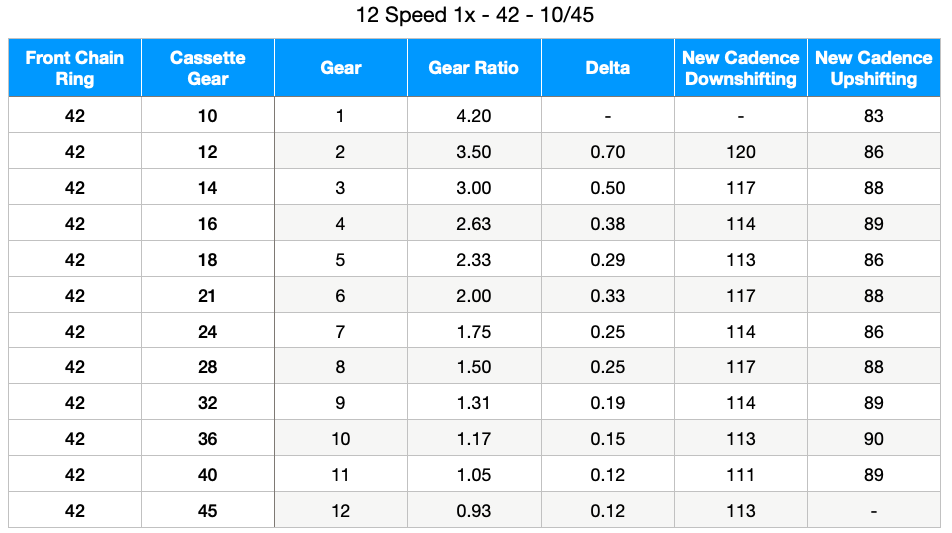
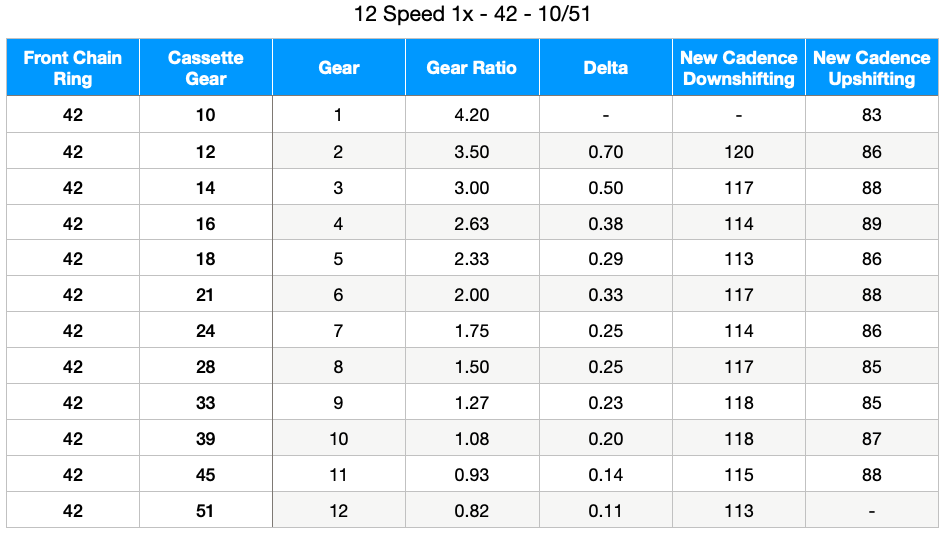
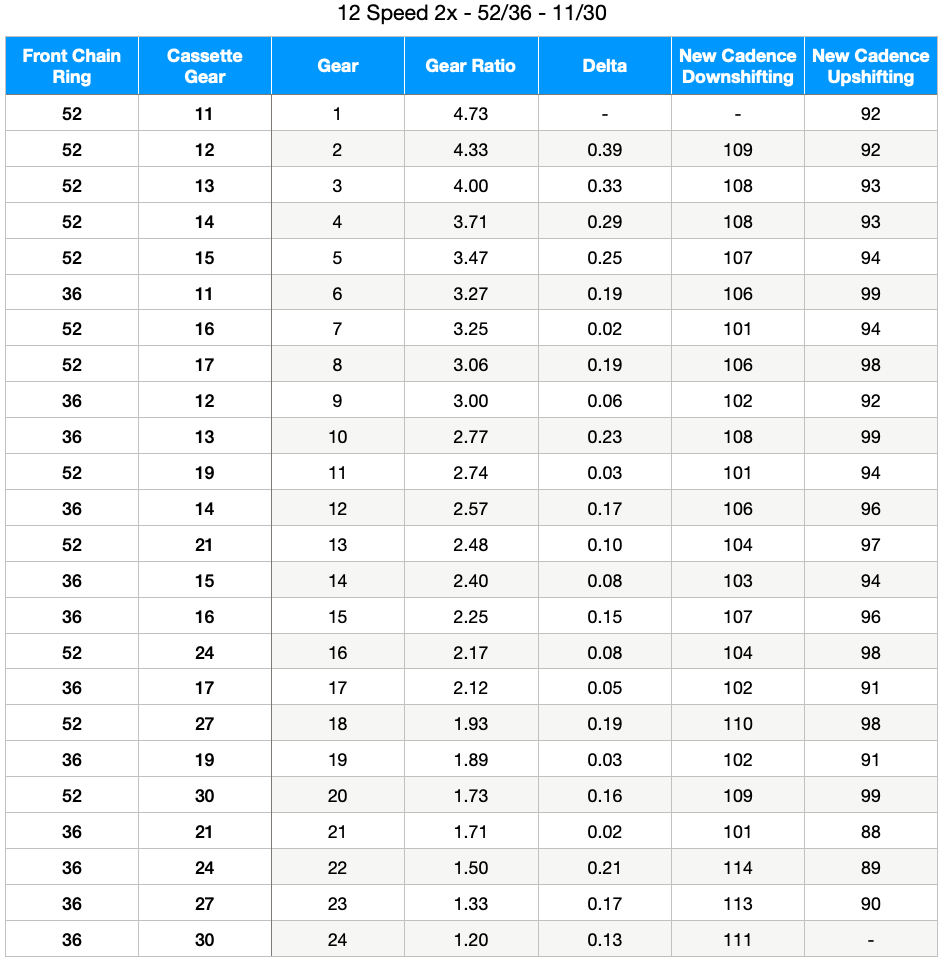
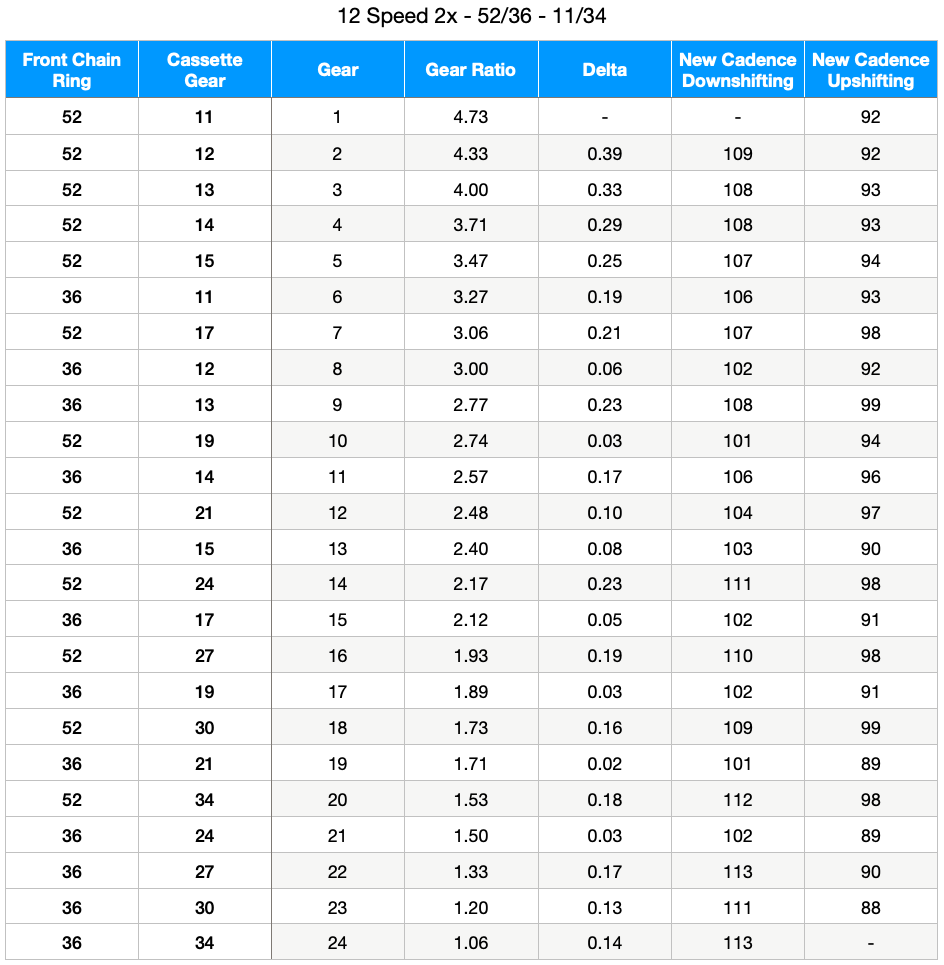
Visualizing the Delta
You can see from the data that the delta between each gear ratio is much more compact with the 2x groupsets. To see this visually, take a look at the following graphs for each groupset which shows the gear ratio and the delta between the two gears.
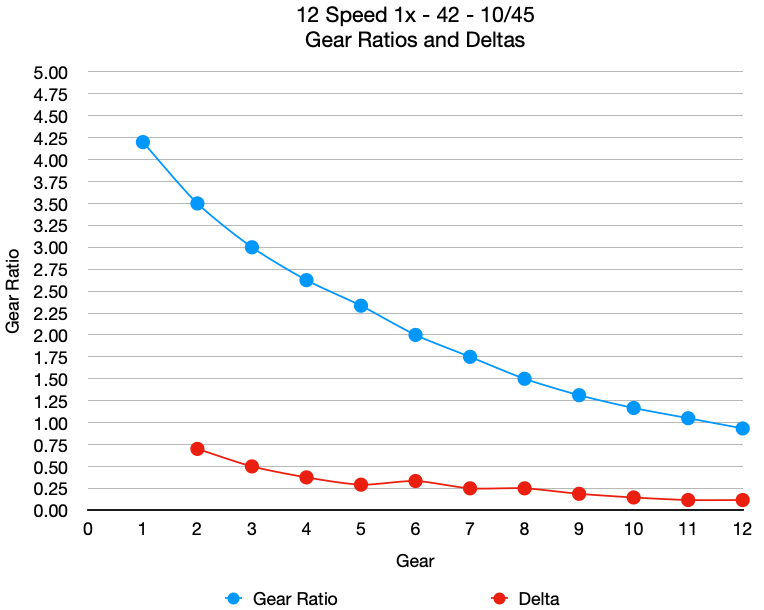
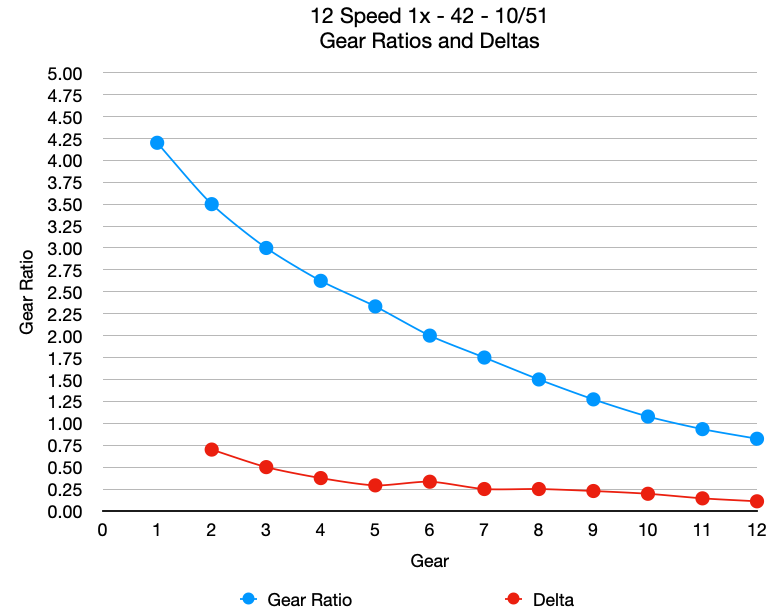
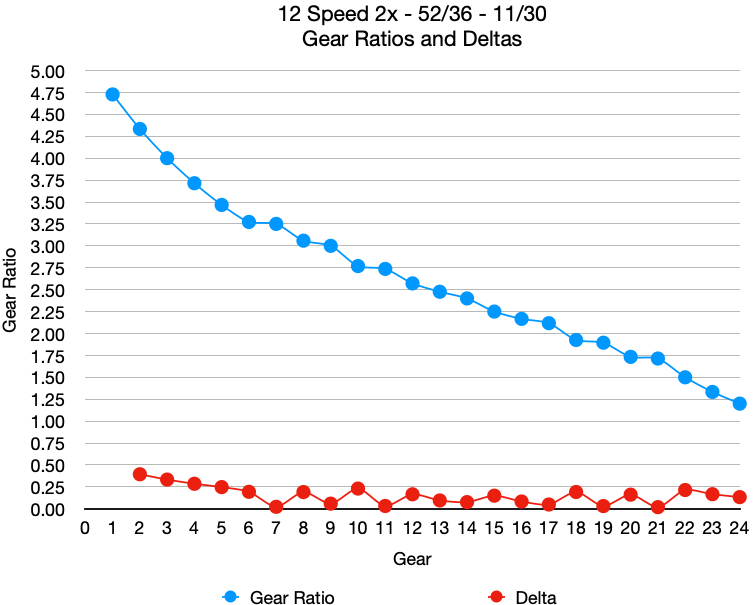
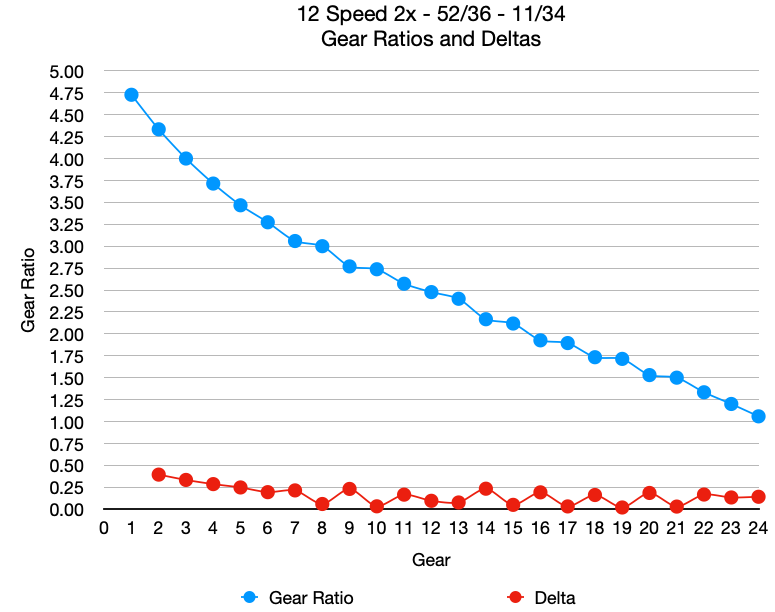
Visualizing the New Cadence Data
The next series of graphs shows the change in cadence when upshifting or downshifting. We assume that the cyclist is pedaling with a cadence of 100 at a specific power. When the cyclist shifts, they want to maintain the same power and therefore must change their cadence to maintain the power. This also assumes that the grade of the ground is consistent during the shift. Changing the grade would alter the power output.
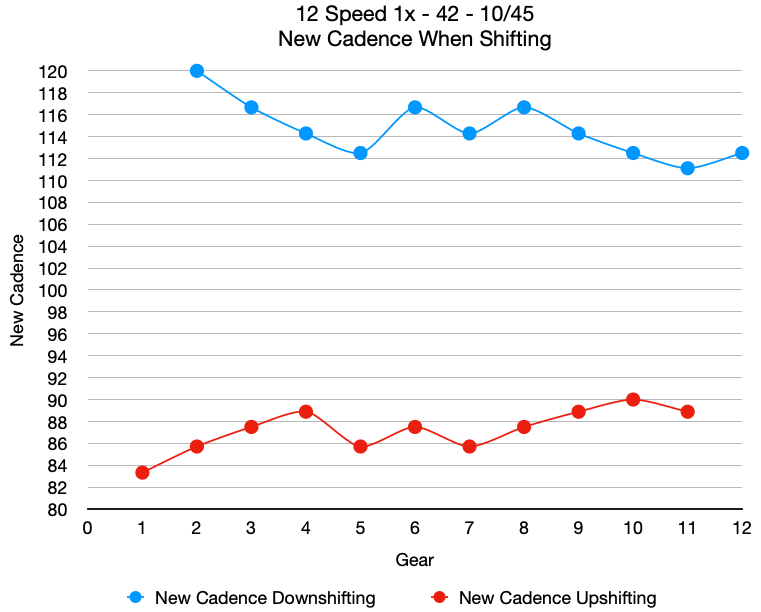
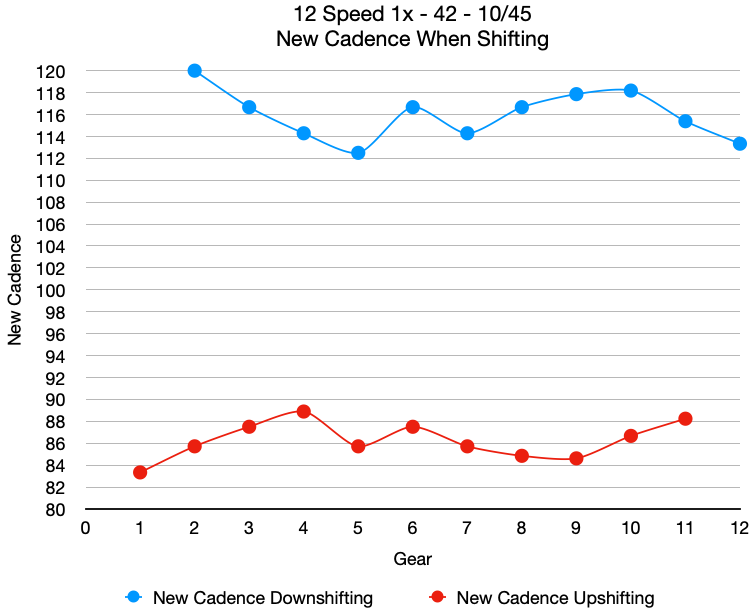
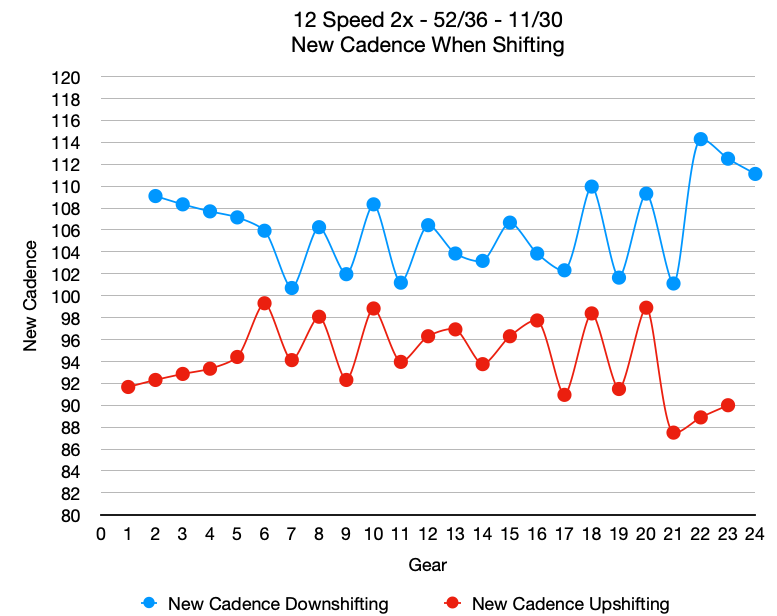
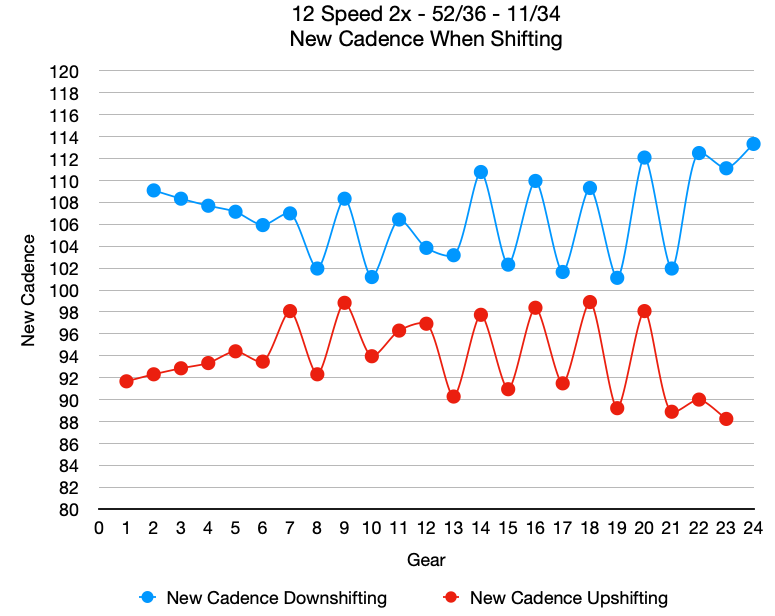
What is Better a 2x Groupset or a 1x Groupset?
Looking at the study above we know that regardless of cadence, a cyclist will burn roughly the same number of calories for the same power output. This is because the cost of unloaded cycling increases and metabolic cost decreases. Therefore picking a 1x or 2x groupset is a personal choice since large changes in cadence when shifting gears will not impact your calorie burn. For me that decision is easy, I hate feeling like I am in between gears so a 2x makes the most sense. For other athletes, that may not be the case.
Shifting Between Front Rings
If you’re looking at the data, you will likely see that you would have to perform some shift magic to change gear ratios in order. Before you write this off, it’s important to note that most of the front ring changes result in very small deltas. With the smaller cassette spread, the new cadence values still stay much closer even if you don’t change front chain rings.
Final Thoughts
If you are looking for a new bike and 1x and 2x are an option, I highly recommend that you pick 2x. For the reasons listed above you will be a faster cyclist. Some people may complain about the weight but after years or research I can tell you small weight changes like this end up being insignificant. Data does not lie. Pick a 2x groupset and end up a faster athlete.

Co-founder at FLO Cycling. Jon manages the day to day operations and acts as the lead engineer for all FLO products.
